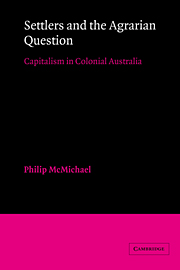Book contents
- Frontmatter
- Contents
- List of tables
- Preface
- 1 The social structure of British hegemony
- PART I THE COLONIAL ECONOMY ENTERS THE WORLD MARKET (1788–1830)
- PART II THE SQUATTING PHASE OF PASTORALISM (1830s AND 1840s)
- 4 Squatting and colonial politics
- 5 Merchants and growers
- 6 Pastoral enterprise in the colonial economy
- 7 The conservative character of pastoralism
- PART III CONFRONTING THE AGRARIAN QUESTION (1840–1900)
- APPENDIXES
- References
- Index
5 - Merchants and growers
Published online by Cambridge University Press: 18 December 2009
- Frontmatter
- Contents
- List of tables
- Preface
- 1 The social structure of British hegemony
- PART I THE COLONIAL ECONOMY ENTERS THE WORLD MARKET (1788–1830)
- PART II THE SQUATTING PHASE OF PASTORALISM (1830s AND 1840s)
- 4 Squatting and colonial politics
- 5 Merchants and growers
- 6 Pastoral enterprise in the colonial economy
- 7 The conservative character of pastoralism
- PART III CONFRONTING THE AGRARIAN QUESTION (1840–1900)
- APPENDIXES
- References
- Index
Summary
INTRODUCTION
The 1830s and 1840s in colonial Australia are commonly called the “squatting age,” when colonial entrepreneurs “put everything into four legs.” The resulting pastoral boom extended the land frontier rapidly, with squatters occupying seemingly boundless Crown land (beyond the official boundaries) for a minimal license fee. Wool exports increased from 1,967,309 pounds in 1830 to 41,426,655 pounds in 1850, accounting for almost 50 percent of Britain's wool supply (Coghlan 1969, vol. I, p. 276).
Traditional interpretations of this period of colonial development stress pastoralism as a successful staple industry and the reciprocal attraction to Australia of banking capital and labor. The image of the growing “Australian economy, hitched to a wool waggon” misconceives what was fundamentally a world-economic process, however (Fitzpatrick 1969, p. 33). Colonial wool was grown as an industrial commodity, and hence the growth of pastoralism consolidated an imperial division of labor. The dominant agent of this relationship, London-based merchant capital, secured colonial wool as a raw material for the textile industry in Britain. By advancing commercial credit to producers in return for their wool clip, merchant-financiers sponsored the squatting expansion.
We saw in Chapter 3 that pioneer pastoralists had sufficient capital to sustain their operations during the time between shearing and the remittance of income from London wool sales, a delay that might last two years. The pioneer combined both productive and commercial functions in his enterprise. Alongside these individual concerns, a second form of pastoralism emerged by the 1830s, with the involvement of colonial merchants in the wool trade.
- Type
- Chapter
- Information
- Settlers and the Agrarian QuestionCapitalism in Colonial Australia, pp. 101 - 118Publisher: Cambridge University PressPrint publication year: 1984



